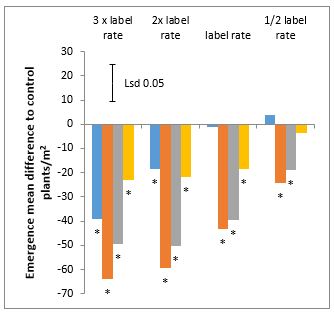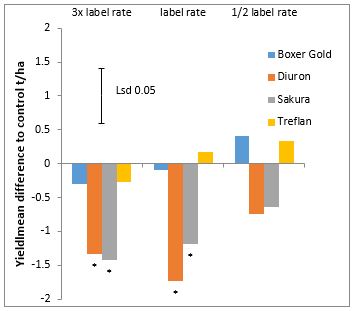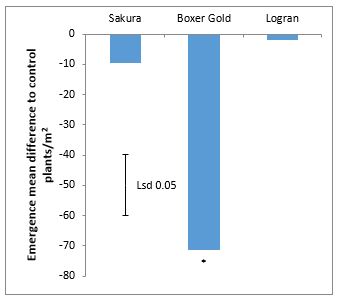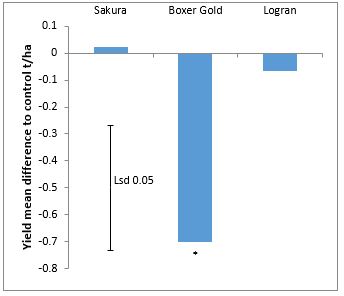Understanding interactions between pre-emergent herbicides and inversion tillage
Author: Tom Edwards, Steve Davies, Glenn McDonald, David Hall and John Moore, Department of Primary Industries and Regional Development. | Date: 26 Feb 2018
Key messages
- Field trials confirm that pre-emergent herbicides can contribute to poor establishment in the first year after inversion tillage.
- Lack of organic matter in the surface layers due to inversion tillage can lead to increased phytotoxicity and leaching of some pre-emergent herbicides, though the effect varies depending on the active constituents and their interaction with soil or environmental conditions.
- After inversion ploughing Diuron® caused crop damage in barley. Crop damage caused by Boxer Gold® depended on the planting system. Sakura® was tolerated by wheat but not barley. Treflan® was tolerated in barley and Logran® was tolerated in wheat.
- Further trials are underway to determine what effect inversion tillage might have on pre-emergent herbicides several years after deep tillage, how this will impact break crop species and what agronomic changes are required to achieve the best crop performance and weed control.
Introduction
Soil inversion through mouldboard ploughing drastically changes the topsoil. In sands, the most common soil type inverted in Western Australia, the soils typically lack secondary structure. Soil inversion results in a large reduction in the soil’s bulk density, topsoil organic carbon content and breaks up remnant root systems, root channels and fungal hyphae which bind the soil (Roper et al., 2015). These soil profile changes can be beneficial through the amelioration of water repellence, reduced compaction to the working depth and deep placement of soil amendments, nutrients and weed seeds but can have implications for seeding crops.
In the first few seasons after inversion, the reduction in soil strength and topsoil changes creates four main issues that can negatively impact crop establishment on very sandy soils (Morris et al., 2010). First, it can be difficult to accurately control seeding depth. Second, complete removal of standing stubble and burial of topsoil increases erosion risk for an acute period until the new crop is established. This erosion can lead to furrow infill and sand blasting of early crop growing points reducing crop establishment and vigour. Third, in soils where inversion increases topsoil clay content and reduces surface repellence, surface evaporation can be increased resulting in more rapid drying of the topsoil in warm and dry conditions.
Finally, with reduced surface organic matter the water and nutrient holding capacity of the topsoil is reduced and the subsoil brought to the surface is typically less fertile. Dramatic establishment failures can occur and this has compelled further research to determine whether these factors are solely responsible or if they are interacting with other detrimental influences.
Changes in topsoil structure and organic matter potentially alter how pre-emergent herbicides behave and may increase crop toxicity. Glasshouse studies have shown that with the reduction in organic carbon, less herbicide will be adsorbed and will more readily leach deeper into the soil profile (Bakker and Poulish, 2015). We believe that standard label rates of pre-emergent herbicide are more active and are reaching the crop root zone at higher concentrations on inverted soils.
The active constituents of each pre-emergent herbicide differs in: crop sensitivity, solubility, what binds them to make them insoluble, how residual they are and what environmental conditions are required to break them down (Weed Science Society of America, 2014). Soil type and rainfall also influences the likelihood of leaching (Congreve and Cameron, 2014). We expect each herbicide type to behave differently within the unique environment created by inversion ploughing and the growing season conditions.
Method
Experiment one at Corrigin using a logarithmic sprayer on barley
The site was repellent sand over gravel at 35-45cm. The soil was inverted using a commercial mouldboard plough in May 2017 to a depth of approximately 30cm. Four herbicide treatments Diuron®, Treflan®, Sakura® and Boxer Gold® were applied using a logarithmic sprayer in June with 85 L/ha of water. The starting herbicide rate was five times the label rate (Table 1) and this fell to half the label rate over the 50m length of each plot (Moore and Jettner, 2002).
The trial was a randomised block design with six replications, each containing the herbicide treatments and a control with no herbicide. Immediately after herbicide application the plots were sown to barley cv Compass (80kg/ha) using knife points and press wheels. Plant emergence counts were done at the same distance from the start of the plots each time so that it could be related to an exact herbicide application rate.
The 50m plots were segmented into three subplots of the same length before harvest. Therefore, when plot harvested we were able to report the yield at various rates of herbicide applied. Rainfall and weather data (Table 2) was collected by the Corrigin DPIRD weather station 7km south of the trial.
Table 1: Registered herbicides applied in both experiments and their respective active (Moore and Moore, 2017). Data on soil mobility sourced from (Weed Science Society of America, 2014).
Registered herbicide | Label rate | Active constituent | Concentration | Adsorption coefficient Koc mL/g | Solubility mg/L | Octanol-water ratio Kow |
|---|---|---|---|---|---|---|
Sakura® | 118g/ha | Pyroxasulfone | 850g/kg | 95 | 3.49 | 2.39 |
Logran® | 35g/ha | Triasulfuron | 750g/kg | 191 | 815 | 0.31 |
Diuron® | 550g/ha | Diuron | 900g/kg | 480 | 42 | 589 |
Boxer Gold® | 2.5L/ha | S-metolachlor | 800g/L | 200 | 488 | 794 |
Prosulfocarb | 120g/L | 1853 | 13.2 | 4.65 | ||
Treflan® | 2L/ha | Trifluralin | 480g/L | 8765 | 0.3 | 118,000 |
Table 2: Rainfall data collected by DPIRD weather stations for Corrigin and Coomalbidgup
Time period | Corrigin trial | Coomalbidgup trial |
|---|---|---|
Sowing date | 20/06/2017 | 30/05/2017 |
Cumulative rainfall (mm) 30 days prior to sowing | 14 | 30 |
Cumulative rainfall (mm) 2 weeks after sowing | 36 | 2 |
Largest rainfall event (mm) over 24 hour period in first 2 weeks after sowing | 19 | 1 |
Experiment two at Coomalbidgup using a roller seeder to plant wheat
Soil at the site was a repellent sand over gravel at 40-50cm. Soil was inverted with a mouldboard plough in May 2017 to a depth of 30cm. Immediately after inversion three herbicide treatments (Sakura®, Boxer Gold® and Logran®), all at the label rate (Table 1), were applied to the soil with 100 L/ha of water. A control treatment with no pre-emergent herbicide was included. Treatments were arranged in a criss-cross design with four nitrogen application timing treatments.
The nitrogen treatments are not presented in this paper as they did not interact with the pre-emergent herbicide treatments. After herbicide application the site was sown with a modified roller seeding unit which increased the strength of the soil surface while also leaving it corrugated. Hoses attached behind the roller trickled wheat cv. Mace (70kg/ha) seed onto the surface, resulting in minimal burial and separation from the pre-emergent herbicide. Rainfall and weather data (Table 2) was collected at the Coomalbidgup DPIRD weather station 20km south west of the trial.
Results
For the Corrigin trial all herbicide treatments reduced crop emergence when applied at both three and two times the label rate. Diuron®, Sakura® and Treflan® treatments significantly reduced crop emergence when applied at the label rate (Figure 1). Diuron® and Sakura® also caused significant impact when applied at half the label rate. For all herbicide treatments there was an increase in crop emergence as the herbicide rate dropped. Diuron® and Sakura® significantly reduced yield when the maximum applied was at the label or three times the label rate (Figure 2). No herbicide treatment significantly reduced the yield when the maximum applied was half the label rate.
For the Coomalbidgup trial Boxer Gold® applied at label rates significantly reduced the emergence by 70% and yield by 700 kg/ha (Figure 3 and 4). Though detrimental to yield in the Corrigin trial Sakura® did not demonstrate any adverse effects on wheat in this trial.
Figure 1: Mean difference of Barley emergence (plants/m2) at eight weeks compared to control where no pre-emergent herbicide was applied at the Corrigin trial. The control had an average emergence of 81 plants/m2. Bars marked with a * indicate treatments that are significantly different from the control (Lsd p=0.05=15).
Figure 2: Mean difference for Barley yield (t/ha) compared to the control where no pre-emergent herbicide was applied at the Corrigin trial. The control had an average final yield of 2.33 t/ha. Bars marked with a * are significant (Lsd P=0.05=0.82).
Figure 3: Plant emergence (plants/m2) mean difference to control where no pre-emergent herbicide was applied six weeks post sowing at the Coomalbidgup trial. Control is equal to100 plants/m2. Bars marked with a * are significantly different (Lsd P=0.05=20)
Figure 4: Mean difference for Wheat yield (t/ha) compared to the control where no pre-emergent herbicide was applied at the Coomalbidgup trial. The control had an average final yield of 3.28 t/ha. Bars marked with a * are significant (Lsd P=0.05=0.46)
Conclusion
Glasshouse trials conducted by Bakker and Poulish (2015) demonstrated that the pre-emergent herbicides Treflan®, Sakura® and Boxer Gold® could severely reduce establishment where topsoil organic matter was reduced through inversion. Our research confirms that in field situations this can translate to yield losses from pre-emergent herbicides in the first growing season after inversion. However, this was not the case for all herbicides tested in all environments and the interaction between the chemical characteristics of the herbicide and the environment is important for determining the likelihood of crop damage.
The scale to which the crop is damaged by herbicide will vary depending on the size and timing of the first rainfall event. Rainfall data indicates that the soil was relatively dry in Corrigin leading up to sowing but within two days of sowing there was a substantial rainfall event. Significant rain immediately after herbicide application can substantially increase the likelihood of a herbicide leaching before it binds to the soil and organic matter (Congreve and Cameron, 2014).
Soil mobility of each active constituent is also influenced by their water solubility, how tightly they bind to soil particulates (adsorption coefficient Koc) and how hydrophilic the compound is (octanol-water partitioning coefficient Kow). Typically there is little clay (depending on soil type) or organic matter around the crop seed after inversion hence little for the herbicide to bind to. This issue is often stated on labels with comment like “The potential for crop damage is increased when the soil has a high potential for leaching” on the Sakura® label and “Crop injury may occur when used in sandy soils with high leaching potential” on the Boxer Gold® label. Water solubility and the octanol to water ratio are useful factors in determining the potential for herbicide movement after inversion ploughing. However, despite there being an order of magnitude increase in solubility from trifluralin to Sakura® to diuron to S-metolachor to triasulfron the yield losses do not follow this pattern as the crop response is a combination of the amount of herbicide received by the crop and its inherent tolerance to this level of exposure.
Despite relatively low solubility Diuron® recorded the biggest yield loss for any of the herbicides tested. The active constituent binds to clay and organic matter in the soil, and leaching is considerably increased when applied to sandy soils with low organic matter (Weed Science Society of America, 2014). When applied as a pre-emergent, the label recommends that sowing depth is increased and that it should be used only with knife points and press wheels where the seed is at the bottom of the furrows (Moore and Moore, 2017). Reduced soil strength and structure can lead to more soil movement when knife points and press wheels are used, so furrow walls are more likely to collapse and infill (Blackwell, 2000). Pre-emergent herbicide incorporated by the tines and moved into the inter-row can then infill on top of the emerging coleoptile. Due to the mobility of diuron and furrow instability, even with knifepoint seeding, this herbicide is not well suited for use in the first few seasons after inversion.
Boxer Gold® caused little damage in the Corrigin trial, even at high rates. Conversely Boxer Gold® was particularly detrimental to crop establishment and yield at Coomalbidgup where there was little separation between seed and herbicide. Both active constituents of Boxer Gold® (prosulfocarb and s-metolachlor) readily adhere to clay and organic matter. Prosulfocarb has slight and S-metolachlor medium mobility in soil (Moore and Moore, 2017). Pre-emergent herbicides that bind tightly to the surface soil are effective in minimum-till systems because they remain close to where weed seeds germinate and has little chance of coming into contact with crop seed in the furrow (Congreve and Cameron, 2014). However, because inversion tillage compromises soil strength, accurate seeding depth can be difficult to maintain. The need to stabilise the soil quickly also means that growers often look to sow immediately in one pass after ploughing, as attempted in the Coomalbidgup trial. When seed cannot be reliably separated from soil-applied herbicide, the risk of crop damage is increased with products like Boxer Gold®.
Pyroxasulfone the active constituent in Sakura® is not very soluble in water but is considered moderately mobile because it binds weakly to soil (Congreve and Cameron, 2014). Although it will likely be more mobile after inversion (Bakker and Poulish, 2015), it is possible it is less influenced by the reduction in topsoil organic matter. Sakura® is an effective pre-emergent herbicide for wheat which has a high tolerance at label rates (University of Hertfordshire, 2013). Conversely barley and durum wheat varieties do not possess this tolerance and Sakura® is not registered. Sakura® may be a suitable option when wheat is sown in the first year after inversion as demonstrated in the Coomalbidgup trial.
Because of increased phytotoxicity from pre-emergent herbicides, there is a temptation for growers to reduce application rates, but more research is needed to define safe, effective rates. This research has indicated that increased herbicide phytotoxicity may not only be due to reduced organic matter but also due to increased soil movement and shallower planting concentrating herbicide near the crop seed. In the second scenario lower doses of herbicide applied could lead to weed populations coming into contact with sub-lethal herbicide rates.
In the case of pyroxasulfone, Busi et al (2012) demonstrated that recurrent applications of sub-lethal doses on an annual ryegrass population lead to non-target site resistance evolving within three years. Non-target site resistance is particularly detrimental to herbicide sustainability because it improves a weed population’s ability to metabolise herbicides and once developed, the population may have resistance to other herbicides with different modes of action even if they have never been applied to that population before (Powles and Yu, 2010).
Conversely, improving our understanding of how herbicides interact with inversion ploughing affords an opportunity to incorporate strategic tillage into an integrated weed management strategy that reduces the risk of evolved herbicide resistance. The soils typically targeted for inversion in WA are water repellent. Weed control on these soils is difficult and they have an increased risk of evolving weed populations with herbicide resistance. Repellence results in slow and uneven infiltration leading to staggered germination of weed seeds and inconsistent herbicide activation. These processes increase the chance that some germinating weeds will likely come into contact with either nil or sub-lethal doses of herbicide.
Inversion buries the repellent topsoil dramatically reducing the non-wetting properties so that these issues are eliminated (Roper et al., 2015). Inversion will also bury weed seeds and when setup properly with skimmers over 95% of annual ryegrass seed can be buried (Douglas and Peltzer, 2004). Such a substantial reduction in viable weed seed provides an opportunity to reduce weed numbers further if there is an understanding of which weed species remain and what herbicides are safe and effective to use after inversion.
Further research is needed to improve our knowledge on how the herbicides will behave in subsequent years after inversion given that it’s a very slow process for organic matter to re-build in the top soil (Roper et al., 2015). Herbicide degradation is strongly influenced by soil type and the associated microbial communities (Congreve and Cameron, 2014), so it is likely that pre-emergent herbicides will continue to behave differently for several years post-inversion. How these herbicides interact and leach under different rainfall patterns, soil moisture conditions and soil types needs to be further understood and safe, yet effective, herbicide strategies developed.
References
BAKKER, D. & POULISH, G. 2015. The phytotoxicity of pre-emergent herbicides on mould boarded soils. Grains research updates, Western Region. Perth, Western Australia.
BLACKWELL, P. 2000. Management of water repellency in Australia, and risks associated with preferential flow, pesticide concentration and leaching. Journal of Hydrology, 231, 384-395.
BUSI, R., GAINES, T. A., WALSH, M. J. & POWLES, S. B. 2012. Understanding the potential for resistance evolution to the new herbicide pyroxasulfone: field selection at high doses versus recurrent selection at low doses. Weed Research, 52, 489-499.
CONGREVE, M. & CAMERON, J. 2014. Soil behavior of pre-emergence herbicides in Australian farming systems-a reference manual for agronomic advisers. Australia: GRDC-publication.
DOUGLAS, A. & PELTZER, S. C. Managing herbicide resistant annual ryegrass (Lolium rigidum Gaud.) in no-till systems in Western Australia using occasional inversion ploughing. Proceedings of the 14th Australian weeds conference, 2004 Wagga Wagga, NSW. 300-303.
MOORE, C. & MOORE, J. 2017. Herbiguide, the pesticide expert on a disk. HerbiGuide, Albany.
MOORE, J. & JETTNER, R. 2002. The effect of glyphosate, paraquat and diquat as a crop topping application on the germination of barley. GRDC grains research updates. Perth, Western australia.
MORRIS, N. L., MILLER, P. C. H., J.H.ORSON & FROUD-WILLIAMS, R. J. 2010. The adoption of non-inversion tillage systems in the United Kingdom and the agronomic impact on soil, crops and the environment—A review. Soil and Tillage Research, 108, 1-15.
POWLES, S. B. & YU, Q. 2010. Evolution in action: plants resistant to herbicides. Annu Rev Plant Biol, 61, 317-47.
ROPER, M., DAVIES, S., BLACKWELL, P., HALL, D., BAKKER, D., JONGEPIER, R. & WARD, P. 2015. Management options for water-repellent soils in Australian dryland agriculture. Soil Research, 53, 786-806.
UNIVERSITY OF HERTFORDSHIRE 2013. The pesticide properties database. In: UNIVERSITY OF HERTFORDSHIRE (ed.).
WEED SCIENCE SOCIETY OF AMERICA 2014. Herbicide handbook of the Weed Science Society of America, Lawrence, KS, USA, Weed Science Society of America.
Disclaimer
Always follow label recommendations. DPIRD does not endorse the use of herbicides above the registered rate or off –label use of herbicides. Crop tolerance and yield responses to herbicides are strongly influenced by seasonal conditions. Note that ® indicates Registered Trademark. Varieties displaying this symbol beside them are protected under the Plant Breeders Rights Act 1994.
Acknowledgments
The research undertaken as part of this project is made possible by the significant contributions of growers through both trial cooperation and GRDC investment, the author would like to thank them for their continued support.
Thanks to the farmer collaborators, John and Stewart Wallace, Ryan Szczecinski, Trevor Schutz and their families and staff. We also thank SEPWA and CFIG for their support and we acknowledge the assistance of the Esperance and Northam RSU.
This research is undertaken through DAW00244 soil water repellence project which is one of the GRDC Soil Constraints West group of projects.
GRDC Project Number: DAW00244
Peer Reviewed By: Andrew Storrie (Agronomo Consulting) and Catherine Borger (DPIRD)
GRDC Project Code: DAW00244,
Was this page helpful?
YOUR FEEDBACK




